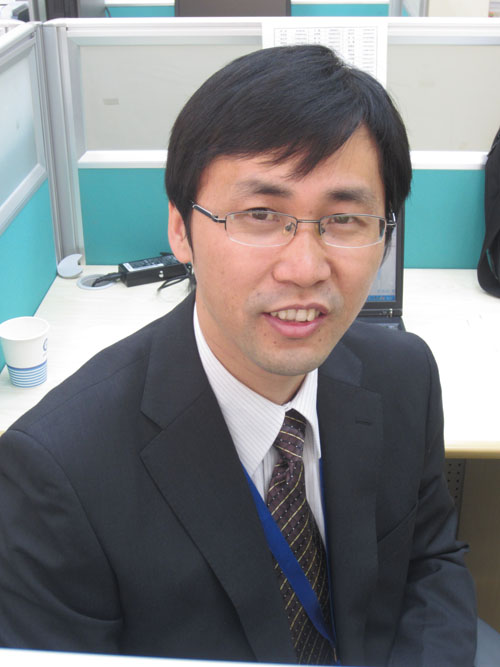 Dr. Fuxiang Zhang
Professor
DNL 1601 group leader
Dalian National Laboratory for Clean Energy (DNL)
Dalian Institute of Chemical Physics
Chinese Academy of Sciences
457 Zhongshan Road
Dalian 116023, China
Tel.: 86-411-84379698
Fax: 86-411-84374447
E-mail: fxzhang@dicp.ac.cn
Dr. Fuxiang Zhang
Professor
DNL 1601 group leader
Dalian National Laboratory for Clean Energy (DNL)
Dalian Institute of Chemical Physics
Chinese Academy of Sciences
457 Zhongshan Road
Dalian 116023, China
Tel.: 86-411-84379698
Fax: 86-411-84374447
E-mail: fxzhang@dicp.ac.cn
Dr. Zhang was born in 1977, earned his bachelor’s degree and an Ph. D. at Nankai University and then joined the faculty. In September 2007, he began his first postdoctoral research to work with Dr. Juliette Blanchard and Dr. Xavier Carrier at the Laboratoire de Reactivite de Surface (LRS), the University of Pierre & Marrie Curie, in France. From July 2008 to September 2011, he worked as a postdoc researcher and an assistant professor at Prof. Kazunari Domen’s laboratory in the University of Tokyo, Japan. Now he is working in the Division of Solar Energy, DNL to develop novel photocatalytic systems for efficient solar hydrogen production from water. To date, he has published ca. 50 SCI papers in some peer-reviewed journals such as Nat. Commun., J. Am. Chem. Soc., Chem. Commun. and J. Catal. etc. with total cited times of over 600 and H-index of 14.
Dr. Zhang’s works were mainly located in the field of heterogeneous catalysis, and focused on development of novel nano-materials and porous materials for some reactions related to environment or energy, from conventional solid acid catalysis to photocatalytic purification and hydrogen production from water. Currently, he is pursuing photocatalytic overall water splitting using wide visible light together with the following topics:
i) Novel synthesis of wide visible light-responsive semiconductors with controllable electronic, crystalline and surface structures
ii) Development of cocatalysts composed of earth-abundant elements
iii) Fabrication of heterogeneous interface for efficient charge transfer
iv) Comprehensive configuration of catalytic systems with high quantum efficiency of water splitting
v) Understanding of reaction mechanism involved in photocatalytic process using kinetic and isotopic analysis, electrochemical technique and advanced characterizations like time-resolved spectroscopic and in-situ Raman spectroscopy.
Representative Publications
1). Shanshan Chen, Yu Qi, TakashiHisatomi, Qian Ding, Tomohiro Asai, Zheng Li, Su Su Khine Ma, Fuxiang Zhang*,Kazunari Domen, Can Li*. Efficient Visible-Light-Driven Z-Scheme Overall WaterSplitting Using a MgTa2O6-xNy/TaONHeterostructure Photocatalyst for H2 Evolution. Angew. Chem. Int. Ed. 2015,54, 8498-8501.
2). Shanshan Chen, Shuai Shen,Guiji Liu, Yu Qi, Fuxiang Zhang,* Can Li*, Interface Engineering of a CoOx/Ta3N5Photocatalyst for Unprecedented Water Oxidation Performance underVisible-Light-Irradiation. Angew. Chem. Int. Ed. 2015, 54,3047-3051.
3) RenguiLi, Fuxiang Zhang, Donge Wang, Jingxiu Yang, Mingrun Li, Jian Zhu, Xin Zhou,Hongxian Han, Can Li. Spatial Separation of Photogenerated Electrons and Holesamong {010} and {110} Crystal Facets of BiVO4. Nat. Commun. 2013,4:1432, DOI: 10.1038/ncomms2401.
4). Fuxiang Zhang, Akira Yamakata,Kazuhiko Maeda, Yosuke Moriya, Tsuyoshi Takata, Jun Kubota, Katsuya Teshima,Shuji Oishi, Kazunari Domen. Cobalt-Modified Porous Single-Crystalline LaTiO2N for HighlyEfficient Water Oxidation under Visible Light. J.Am. Chem. Soc. 134 (2012) 8348-8351.
5). Fuxiang Zhang,Kazuhiko Maeda, Takata Takata, Kazunari Domen Improvement of the photocatalytichydrogen evolution activity of Sm2Ti2S2O5under visible light by metal ion additives, J. Catal., 280 (2011)1-7.



